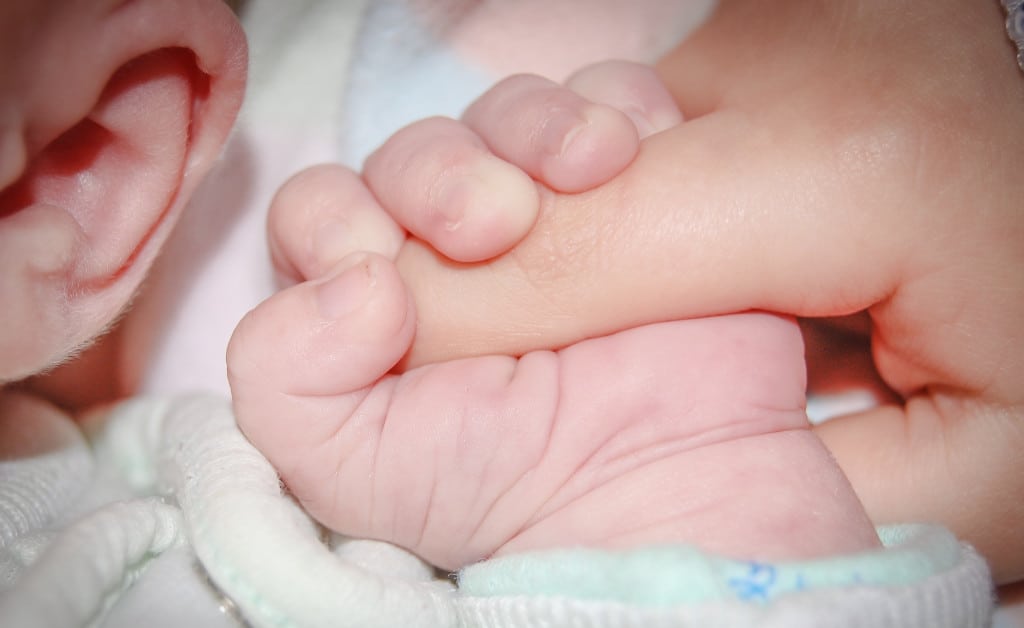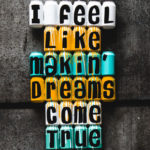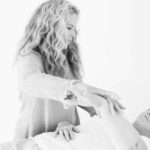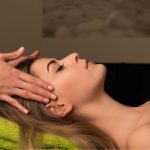Retained Primitive Reflexes

Our Central Nervous System is our Control Centre for living. It is essential for perceiving the world around us, for moving around and doing things in it, for thinking, feeling, learning, communicating, working, playing, loving, and surviving.
Anatomically, the central nervous system is composed of the brain and spinal cord. The brain may be divided into a hierarchy of centres:
1) The most evolved thinking and integrating part, the cerebral cortex at the top
2) The older brain of instinct and housekeeping in the middle
3) The oldest, the brainstem, just above the spinal cord
Of course, these “centres” are not isolated; they are quite complexly interlinked, but separating them helps to understand brain processes.
“Primitive” means “earliest of its kind”, and the nerve centres controlling primitive reflexes are in the oldest (most primitive) part of the brain, the brainstem.
In the womb and the early months of life, the higher centres of our central nervous system are not fully developed. During this time we are protected and assisted by reflexes, controlled by the lower centres of our brain. A reflex does not involve thinking; it is an involuntary response. Given an external stimulus (e.g. touch, noise, heat) or internal stimulus (e.g. hunger), there is an automatic, involuntary reaction if the relevant reflex is active. Reflex response varies from simple muscular movement (e.g. moving a body part away from pain) to quite complex reflexes involving body movements, breathing, perceptual and hormonal changes.
Primitive reflexes are needed for survival and development in the womb and in early months of life. As higher centres begin to mature enough for conscious control of activity, the involuntary, uncontrollable reflex responses are a nuisance except in special circumstances (e.g. quickly moving a body part away from excessive heat). The reflexes anatomically and neurologically stay for the remainder of our life, but, if all is well, they are integrated into higher centre control.
Primitive reflexes ideally begin to function in a particular order and are integrated in a specific sequence. If they are retained out of sequence, they disturb the development and integration of subsequent reflexes. If they are retained beyond their normal age of integration they can disturb some or all of the functions of higher centres, which include behaviour, learning, the integration of gross or fine movements and more. Basically, the perception of our inner and outer environment and our response to it may be disturbed; that is, conscious life may be disturbed.
What causes reflexes to be inappropriately retained? Like all questions on the nature of life and health, there are no absolute answers. From research and experience, it appears that trauma of some kind is involved somewhere between conception and the early months of life. The trauma can be physical, chemical, hormonal or other forms not yet researched. In utero (in the womb during pregnancy) many chemicals and hormones can pass through the umbilical cord; all manner of traumatic events can occur in the delicate early months of life, but the two big ones appear to be Vanishing Twin Syndrome at around 2-3 months in utero and birth trauma. Statistics and clinical observation show that there may be genetic factors. These appear to be predispositions, which raise the probability of problems arising from trauma. What can you do?
Test at Home
Questions to Ask
Common questions that would suggest retention of retained neonatal reflexes are –
- When you were pregnant, did you have any medical problems?
- Was your child delivered at term or early/late?
- Was the birth process unusual in any way? (forceps, suction, C-section, induction, long, short)
- Was your child small for term?
- Were there any unusual physical signs? (jaundice, bruising, distorted skull)
- Was there any difficulty feeding or keeping it down? Did your child easily feed off both breasts?
- Between 6 to 18 months, was your child very active or demanding? Or particularly quiet and unresponsive?
- Did your child develop a violent rocking motion when standing or sitting?
- Was your child a ‘head-banger’?
- Did your child start walking before 10 months or after 16 months?
- Did your child bum shuffle or skip the cross crawling stage?
- Was your child late when learning to talk (2-3 words by 2 years)?
- Did your child experience any serious illness or seizures in the first 18 months of life?
- Was there any sign of eczema, asthma or allergies?
- Did your child have any adverse reactions to childhood vaccinations?
- Did your child have difficulty learning to dress his / herself?
- Did your child suck their thumb past the age of 5?
- Did your child wet the bed regularly past the age of 5?
- Does your child suffer from travel / motion sickness?
- Did your child have trouble establishing hand dominance or crossing the midline with objects?
At school
- Did your child have problems learning to read and / or write in the early years at school?
- Did your child have difficulty telling the time on an analogue clock?
- Did they have difficulty riding a bicycle?
- Did they suffer from recurrent sinus or ear infections or headaches?
- Did they have difficulty catching a ball?
- Did your child have ‘ants in the pants’?
- Did your child make numerous mistakes when copying from the board?
- Does your child occasionally miss letters or write them backwards?
- Does your child have an awkward pencil grip?
- Has your child ever been diagnosed with any conditions such as Low Muscle Tone or ADHD?
- If there is a sudden noise, would your child over-react?
If you have answered yes to some or all of these questions, there is likely an immature central nervous system indicating the retention of some primitive reflexes.
These questions have been modified from ‘Attention, Balance and Coordination: the ABCs of learning success’ by Sally Goddard Blythe (2009).
Home Tests
Here is a collection of tests for you to do at home on your children. They are designed to indicate the likelihood of retained neonatal reflexes.
If these reflexes have been retained then the child may be trying to give you warning signs in their everyday activities; these symptoms are listed under each of the specific reflexes.
Look with eyes that see. Keep your eyes open and you’ll see so many additional signs of difficulty. And with this understanding you can repeat the task at home so they too can observe the difficulty displayed while performing a seemingly simple task. It can open their eyes to see that the child is not failing to perform due to a lack of trying, but due to a lack of communication between brain and body.
Some at home tests can help to discover if the child has retained the impulsive muscle pattern of the reflexes –
1. Testing for the ATNR

- Ask the child to get on all fours with the arms straight, fingers pointing forward, and the head in neutral. With their weight over their hands, the parent rotates the child’s head left or right. If their elbow bends on the opposite side of head rotation (as would in the infant) OR the weight shifts posteriorly (i.e. off the hands) then the reflex is probably present.
- Alternatively, have the child standing with arms straight out in front of them at shoulder height. Ask the child to turn their head fully to the left or fully to the right while maintaining the position of the arms out front. If the torso and arms turn in the direction of the head or if the arms drop, this reflex is likely present. This signifies that the child has not yet disassociated neck movement from shoulder movement.
2. Testing for the Mouth Reflexes
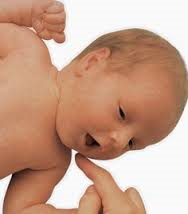
These are the Rooting, Babkin and Juvenile Suck reflexes
Lightly stroke (with a brush or finger tip) from the outer corner of the nose downward beyond the corner of the mouth.
- Movement of the mouth or turning of the head indicates the rooting reflex.
- If either hand moves, then this indicates the Babkin reflex.
- If stimulation above the central area above the top lip results in pursing the lips, this indicates the suck reflex.
3. Testing for Palmar Reflex
Standing with the feet together, elbows bent and away from the body with palms facing upward. Gently stroke along the creases of the palm from between the thumb and index finger toward the heel of the hand. Repeat 2-3 times. If the thumb, fingers or elbows move inward then this reflex is probably present.
Keeping the arms straight out in front, ask the child to wriggle all 10 fingers as though they were playing a piano. Watch for excessive wrist flapping being used instead of the smaller muscles of the hand or movement of the tongue and mouth. This reflex, if retained, can contribute to difficulty in writing and increased energy expenditure while writing or performing manual tasks.
4. Testing for the Sagittal Tonic Labyrinthine Reflex
Lying face down on the ground with palms facing down ask the person to hold the head off the ground and raise the legs simultaneously keeping the legs straight (aka the superman).
If they’re unable to keep their legs straight, then the Sagittal TLR may be present.
This one is greatly performed with music. Place a like-coloured sticker on the right hand and left knee and a different like-coloured sticker on the left hand and right knee. Ask the child to march on the spot as they tap their hand to their opposite knee to match up the stickers. If they turn on the spot, their rhythm is off, or if they begin to tap the same-sided leg, this reflex is likely to be retained. This is a great way to detect gross motor control issues, and if the child displays more difficulty when moving to the beat of the music, it may signify auditory processing issues.
5. Testing for the Galant Reflex

With the person on all fours, lightly stroke down one side of the lumbar spine towards the sacrum (from occiput to sacrum tests for the Perez reflex). If they move their back (typically arching or away from the stroke) then the reflex is probably present.
6. Testing for the Symmetrical Tonic Neck Reflex (STNR)
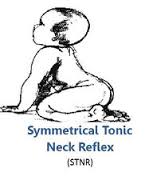
With the person on all fours with the weight forward over their hands, the parent flexes the neck fully (looking down) and hold for 5 seconds, then slowly extend the neck (looking up) and hold for 5 seconds. Repeat 3 times. If the child alters their body position in any way then the reflex is probably present.
Look for:
- shifting of weight backward
- arching back
- bending arms
During ALL these tests it is ok to ask the child to try and hold the desired posture.
8. Testing for isolated upper and lower body movements
By age 8-10 years a child should be able to isolate their leg rotation from that of their upper body. This isolation of muscle control relies on postural reflexes and appropriate tone in the body’s extensors (i.e. the muscles that keep them upright, mostly placed on the backside of their body)
Ask the child to walk forwards and backwards with their feet turned outwards (duck walk). If you notice any of the following, then there is a high chance your child has retained the Moro reflex.
- they can’t turn their feet outward
- bending forward
- arms / hands turning outwards
- an inability to walk smoothly
Ask your child to walk forward and backward with their toes pointing in (pigeon walk). If you notice any of the following there is high chance your child has retained the Moro reflex.
- they can’t turn their feet inward
- bending forward
- arms / hands turning inward
- an inability to walk smoothly
These tests were modified from ‘Attention, Balance and Coordination: the ABCs of learning success’ by Sally Goddard Blythe (2009) and ‘Primitive Reflex Training; Visual Dynamix’ by Lori Moybray (2010) – a great source for corrective exercises targeting the primitive reflexes.
Of course, if you have any suspicions that your child may still be displaying these reflexes (whether by answering yes to some or all of the above questions, by noticing some of the symptoms outlined in each of the reflexes or by performing some of these at home tests) then find a local practitioner to help you with your child.
Rehabilitating children with an immature central nervous system (CNS) can require the assistance of many health practitioners. These include but are not limited to Behavioural Optometrists, Occupational Therapists, Physiotherapists, Dieticians, Naturopaths, Sound Therapists, Play Therapists, Paediatricians, Educational kinesiologists and General Practitioners.
For any more information on mini-workshop for teachers and educators working with children or mums with bubs, contact Jose Toussaint
Information and workshops are available on how to distress with your child.
Email: info.josetoussaint@gmail.com
Mobile: 0434 626 307

